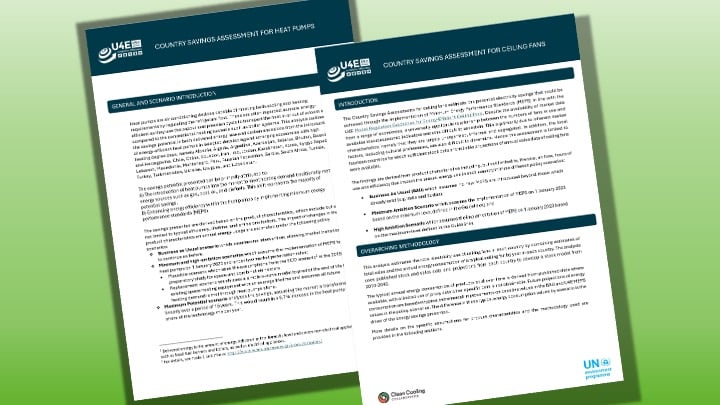United for Efficiency (U4E) has published new savings assessments for energy-efficient ceiling fans and heat pumps. The new assessments add to the U4E Global Map of 156 developing countries and emerging economies, which covers lighting, refrigerators, room air conditioners, electric motors, and distribution transformers. Together, these six product groups consume more than 50% of electricity worldwide.
The new analyses cover a limited number of countries. This is due to the inherent market characteristics of ceiling fans and heat pumps, namely that they are largely unorganized, informal and segregated. Hence, the assessment is limited to the regions for which sufficient stock data and reliable projections of annual sales data were available.
According to U4E Energy Efficiency Expert Saikiran Kasamsetty, ceiling fans are often considered the first means to respite from heat. Despite their relatively low energy consumption compared to air conditioners, the energy demand of ceiling fans is still significant due to their wide proliferation and unchecked energy performance. “Implementing MEPS of ceiling fans and upgrading to modern technologies, like brushless direct current fans, shall result in substantial electrical, economic, and environmental benefits”, he said.
While most of the current focus is on reducing cooling energy demand and associated consumption, heating is a fundamental need and accounts for significant energy demand in many countries. “Heating, even in developed countries, is still met through conventional ways like boilers, which heavily rely on fossil fuels. Heat Pumps are sustainable air conditioning devices which cater to both cooling and heating needs and are highly energy efficient, leading to significant electricity savings”, Kasamsetty concluded.
The new assessments are an important addition to the Country Savings Assessments, considered one of U4E’s most valuable tools. The analysis shows how investing in energy-efficient products could result in financial, environmental, energy, and societal benefits.
Heat Pumps
Heat pumps are air conditioning devices capable of meeting both cooling and heating requirements by regulating the refrigerant flow. These are often regarded as more efficient as they use the vapour compression cycle to transport the heat in or out of a room compared to conventional heating systems such as boiler systems.
The Heat Pumps Savings Potential Assessment outlines the savings potential in both delivered energy use and carbon emissions from the introduction of energy-efficient heat pumps in 29 selected developing and emerging economies with high heating degree days, including Albania, Argentina, Bosnia and Herzegovina, Korea, and Uzbekistan, among others.
According to the analysis, switching to efficient heat pumps will reduce the energy consumption of the energy delivered in 2040 by about 20%. The annual savings in 2040 in the minimum ambition scenario translates to about 1.7 PWh , delivering energy savings and saving 120 billion USD in electricity bills and abating nearly 130 million tonnes of carbon emissions.
Ceiling Fans
The Country Savings Assessments for Ceiling Fans estimate the potential electricity savings that could be achieved by implementing Minimum Energy Performance Standards (MEPS) in line with the U4E Model Regulation Guidelines for Energy-Efficient Ceiling Fans.
The analysis takes a comprehensive approach to estimating each country’s total electricity use of ceiling fans. It combines estimates of total sales and the annual energy consumption of a typical ceiling fan by year in each country, using published stock and sales data and projections to develop a stock model from 2010-2040.
The document covers the following countries: Bangladesh, Cambodia, India, Indonesia, Lao People’s Democratic Republic, Malaysia, Pakistan, Philippines, Singapore, Sri Lanka, Sudan, Thailand, and Viet Nam.
Due to the limited availability of data, U4E has only been able to analyze these countries so far. Therefore, it is not possible to generalize the savings to ceiling fans. However, the overall savings, broken down by country, are available in the document.
